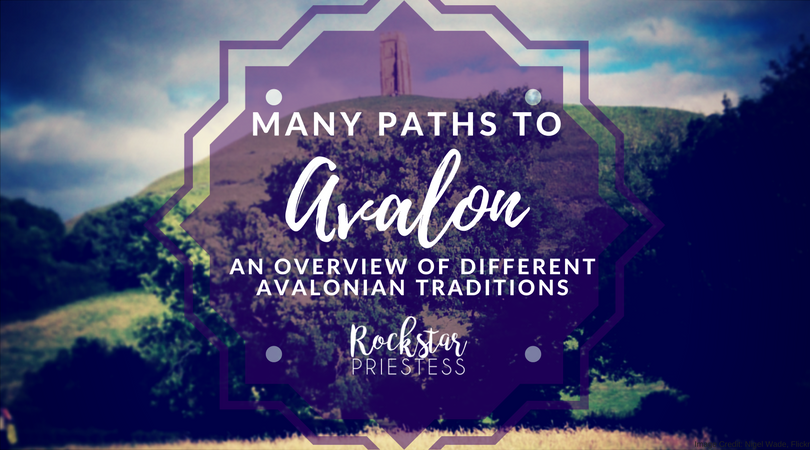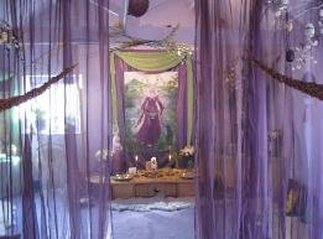 If you are spiritually inspired by Avalon, you will soon discover that there is not just one Avalonian tradition: There are loads. LOOOOOOADS.
If you are spiritually inspired by Avalon, you will soon discover that there is not just one Avalonian tradition: There are loads. LOOOOOOADS.
Avalon holds a powerful spell over us in the modern world. It represents the spiritual counterpart of the celtic world: the hidden, unknown, devotional aspects of times gone by. As we sink into our discovery and re-construction of what spirituality might have been like before, the otherworldly paradise of Avalon appears in myth and legend as a holy isle, an important sacred site in many old celtic myths and stories.
I spent a year training in one Avalonian tradition: now I am training in another. I LOVE Avalon, and although I found a tradition that resonated strongly with me, I find it fascinating and wonderful to learn about Avalon from different perspectives and points of view.
Everyone sees something different in Avalon: and that’s OK. Avalon is an island surrounded by shifting, ever-changing mists: some folks may approach Avalon through a scholarly way, others a devotional way, others a magical way… there are so many paths to avalon. Remember, this is not patriarchal religion, where there is only One True Way – this is Goddess Spirituality, where there are many playful paths, and all have their own wisdom and poetic truths to tell.
So here is a summary of some of the more well known Avalonian traditions. It gets a bit tricky to give them a name, as a lot of them are known as the Avalonian Tradition, but I have tried my hardest!

- Glastonbury Avalonian Temple Tradition.
This is the Tradition spearheaded by Kathy Jones that is based in the Goddess Temple in Glastonbury, Avalon. This tradition is a Goddess-only tradition, and reveres the many goddesses of Britain as we turn around the Avalonian Wheel of the Year. The Wheel of the Year honours the Goddess in Maiden, Lover, Mother and Crone (Imbolg, Beltaine, Lammas and Samhain) as well as as the Mother of Fire, Water, Earth and Air (Spring Equinox, Midsummer, Autumn Equinox and Midwinter), with the Lady of Avalon, the embodiment of the energies of Avalon in the centre of the Wheel of the Year.
It’s a very intuitive, free-form tradition, with the Avalonian Wheel of the Year and devotion to the Goddess as it’s main focus. The tradition itself discourages magical practices like spells and encourages surrender to the Goddess. I’m a big fan: I love it, this is the tradition I trained in and it feels like home to me.
Both Men and Women are welcome in this tradition.
You can learn more about the Goddess Temple Tradition here and read Kathy’s book about it Here.

2. Jehnah Telyndru’s Sisterhood of Avalon
This is another Goddess-centric Avalonian tradition spearheaded by Jhenah Telyndru. This Women’s Mystery Tradition is a path of personal transformation and development – it has strong tenants of personal responsibility and healing.
It is more of a reconstructionist approach to Avalon that the Glastonbury Peeps, who are very imaginative and not that bothered about scholarship. The Sisterhood of Avalon are big on scholarship (which makes sense, as Jhenah Telyndru is an academic with a PhD in celtic studies) and encourage it’s adherents to read about and research as much as they can about celtic culture and mythology. As a result this tradition is super Celtic-inspired – they work with the powers of the Sea, Sky and Land, and with the goddesses of the Welsh Tradition as it is likely people did in ages past in Britain.
Like the Glastonbury Tradition, the Sisterhood of Avalon holds Glastonbury to be a sacred place, and many parts of their tradition are linked in with the landscape of Glastonbury. Again like the Glasto tradition, the Sisterhood discourages spells as part of their practice: the Sisterhood prefers to work with the Goddesses to create change from within.
The Sisterhood of Avalon is based in the USA and there is a good book written by it’s founder called Avalon Within, describing some of the main parts of the tradition.
This is a ladies only tradition!
You can learn more about this tradition by clicking Here and by reading Jhenah’s book here.

3. The 13 Moon Mystery School
This is a highly devotional tradition, that focuses on the Goddess as expressed through 13 archetypes. It was spearheaded by Ariel Spilsbury, and considers itself an Avalonian Tradition, continuing the practices of the Priestesses of Avalon of old: to live fully in the Love of the Mother Goddess, and embody her Love on this earth through the 13 Archetypes of the Goddess.
This tradition is not as earthed in the traditions of the Celts or in the sacred landscape of Glastonbury as the previous two. From the work I have done in this tradition I feel this tradition has a very high-vibe, spacey energy to it, and it’s very beautiful.
This tradition is based out of California, and alas, it has lots of depth but is very very expensive to train in! And I think it’s for Men and Women.
You can learn more about it here.

4. The Chalice Centre’s Avalonian Tradition
This tradition is the least Goddess Focused of the traditions I’ve discussed so far: it works with both the Masculine and the Feminine to create a druidic approach to the Avalonian Mysteries. Created by Mara Freeman, a druid who lives in Wales, this tradition works with the ways of Morgan (the inner, lunar practices of the feminine), Merlin (the shamanic, nature-connecting practices of the Druids) and the mysteries of the Holy Grail.
Like the Glastonbury and the Sisterhood traditions, the Chalice Tradition has a focus on Glastonbury as a sacred place, but rather than a focus on just the Goddess, the Chalice Tradition is all about the Arthurian stories and mysteries, drawing together Pagan and Christian influences. This tradition, which is heavily inspired but he quest for the Holy Grail – which is of course the Quest for the divine Feminine!
Unlike the others, this tradition includes practices familiar to modern witches, and is partly anchored in the occult revival of the 20th century, which is wonderful for peeps who crave a bit of witchery in their Avalonian practice.
It welcomes both Men and Women, and you can read more about it here or read Mara’s book here.
**
There are many, MANY more Avalonian Traditions: any tradition that is heavily inspired by Avalon counts as an Avalonian Tradition. Here I have just named a bunch of the bigger traditions that I’ve come across and been involved with. There are Avalonian inspired Druid traditions, witchcraft traditions, priestess traditions…. and everyone can be touched and inspired by a different facet of Avalon. For some, the alchemical quest of the Grael might light their fire. Others are impassioned by the idea of an Island of Women Priestesses, others by Glastonbury as a Faery Portal, still others as a christi-pagan tradition or by the goddess Morgan le Fey…
Many folks make their own way through the Avalonian mists and live their own personal tradition, picking bits of one and parts of another, and relying on their own ingenuity to make up the gaps.
I love Avalon. Do you know of any other traditions rooted in the magic of Avalon?

Great post! I had come across most of these in my search last fall, upon returning from our honeymoon in Glastonbury and needing to quench my continued yearning for Avalon – I ended up becoming a member of the Sisterhood of Avalon last year at Calan Gaef/Samhain, and so far it’s been great! I really loved the orientation process – lots of time to focus on self-reflection and interaction with others in your orientation group. I hope to be able to do one of their intensives and/or attend the Ninefold Festival at some point, but I also want to continue to craft my own personal Avalonian/Priestess practice. Thanks for this info!
I have studied with the Sisterhood of Avalon, but I had to drop out because I became ill and was unable to keep up. I’m so thrilled to see other Avalonian traditions, and I’ll definitely look into these. Thank you!
Yay! So glad Rose! What was it like in the Sisterhood of Avalon?
It’s lovely to see some inclusive posts coming out about the Greater Avalonian Tradition, recognizing its incredible diversity (which I consider to be its strength)! I hope you will consider stopping by our site, and possibly adding us to your list of groups (The Avalon Druid Order at http://www.avalondruidorder.org).
A number of us were once members of SOA, but left to work from a different focus which includes the Brotherhood. I’ve also had the pleasure of attending one of Kathy Jone’s rituals at the Goddess Temple. Both of these groups are quite different from our own, as are groups and circles by Mara Freeman, Nicholas Mann, and others –but we are all necessary if the Tradition’s wisdoms are to survive in their entirety.
So, that said–thank you once again for your post and–
Bendithion Afallon!
(Second try on this post)…
Greetings,
And thank you for your inclusiveness! It’s such a rare treat to see posts that recognize the glorious diversity of the Greater Avalonian Tradition. A number of our members trained with SOA, and I’ve also attended rituals led by Nicholas Mann, and by Kathy Jones at the Goddess Temple, and can attest that these mentors and groups (while all valid) offer very different experiences of Avalon than do we.
It’s impossible to preserve the Tradition wisdoms in their entirety without the work of ALL of these, and other Avalonian mentors and groups. I hope you will consider dropping by our site, and possibly mentioning us in future posts.
Until then, thank you for posting.
Bendithion Afallon!
Yes! Not one person knows how to get to Avalon – every group and perspective is a different way, leading to a full round view! <3
Lovely site! Thank you for providing it. I know of two more Avalonian resources for you:
The Avalon Druid Order (ADO) is an American Avalonian Order established in 2004. Spiritual practice centres on self-transformation through a dual Healing Cycle, and reclaiming authentic identity and community, through spiritual work and practice in 3 Wisdom Circles: Hearth (Women’s Mysteries); Henge (Men’s Mysteries); and Tribes (integrated Grove Mysteries).
The Order teaches Avalon’s Root Wisdoms, the earliest known spiritual beliefs and practices of Avalon’s First Ancestors; the pre-Celtic native people of the Isles and Western Europe. Training is provided through a tutored Aspirant orientation/home study course, which introduces Seekers to Traditional teaching methods and provides the basics for participation in our spiritual community. It is also provided through bi-weekly telephone chats (conference calls) and incorporated into community life. Study and training areas include: Avalon’s early oral tradition, sacred stories, song, and dance, sacred landscape zodiac and star temple (not modern astrology-based), and Traditional healing and herbcraft. The community is divided into 3 groups: Aspirants (provisional members or membership candidates); Druids; and Tribes (community members who are not Druid clergy). Currently, we have a small, working membership ranging from Nova Scotia, Canada to Florida, USA.
In addition to local Aspirant and Grove circles, the ADO maintains a cyber community, through which members may share studies and ritual ceremony at a distance, and hosts annual Gatherings (live, during Samhain-tide, and cyber gatherings at Beltane or Midsummer). We hope to resume our occasional pilgrimages to Wales, Scotland, and/or South West Britain, in the very near future.
The second group is The Avalon Chalice Centre, established and directed by published Avalonian author, Mara Freeman (https://www.chalicecentre.net).
(Nicholas Mann led an Avalonian men’s circle in Glastonbury for a time, but I believe that disbanded sometime before the COVID lockdowns. Interested readers can probably find out from the town message and events boards.)
Thank you once again.
Bendithion Afallon!